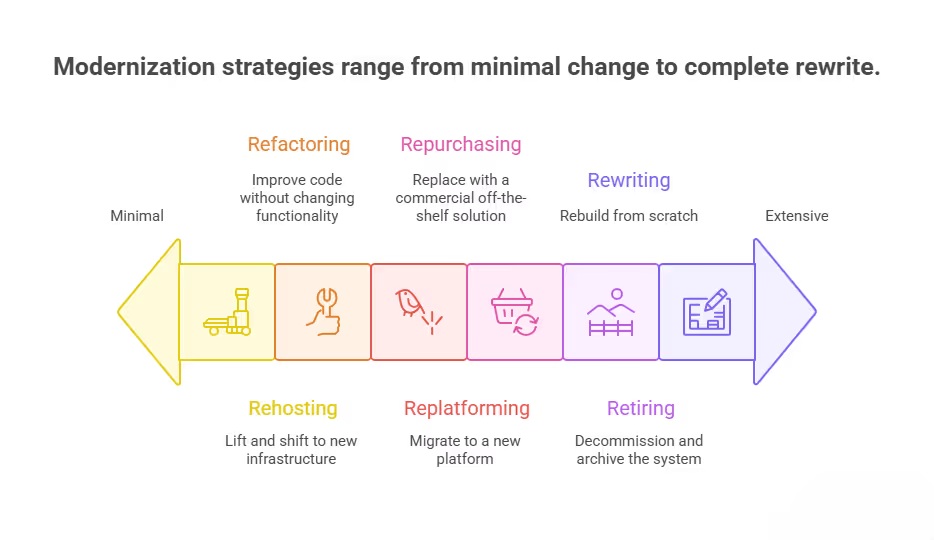Software Modernization Strategies

Artificial intelligence is reshaping how companies approach Software Modernization Strategies. Instead of relying solely on manual assessments, AI can analyze legacy systems, map dependencies, and recommend the most effective modernization paths. It helps reduce risk by automating testing, detecting hidden issues, and predicting how changes may impact system performance.
AI also equips leaders to make better decisions. Predictive analytics can estimate costs, timelines, and long-term benefits for various approaches, whether replatforming, containerizing, or moving to the cloud. Beyond implementation, AI continuously monitors applications, highlighting inefficiencies and suggesting optimizations before they become costly problems.
Integrating AI into Software Modernization Strategies allows organizations to modernize faster, with greater control, fewer disruptions, and measurable outcomes. While AI does not replace human judgment, it provides the insight and speed needed to turn complex modernization efforts into tangible business results.

Why Legacy Systems Are Still Everywhere
1. They Work. Until They Don't.
Most legacy systems still perform the tasks they were built for. They’ve been around for decades because they’re stable and critical to core operations. But over time, these systems become harder to scale, maintain, and integrate with modern tools. What once provided operational continuity now becomes a bottleneck.
Consider banks still relying on mainframe systems for core banking operations. They still function, but can’t adapt to new digital experiences like instant payments, AI-powered fraud detection, or mobile-first banking interfaces.
2. They're Tightly Integrated
Legacy systems are deeply embedded across multiple departments. They’re not isolated components, they’re tied to workflows, databases, and user roles across the organization. Replacing or even updating one module without affecting others is extremely difficult.
For example, an order management module may be linked to procurement, inventory, finance, and delivery systems. Changing just one piece without a full understanding of the dependencies could break critical processes.
3. No One Wants to Touch the Old Code
Languages like COBOL, Delphi, PL/1, and RPG are still widely used, but the number of developers proficient in these is shrinking. The retirement of mainframe engineers poses an existential risk. Even worse, much of the legacy code lacks documentation.
Every line becomes a black box.
Teams spend more time understanding the code than improving it. This leads to rising maintenance costs and zero innovation.
The Real Cost of Standing Still
- Security Risks: Legacy systems lack modern encryption standards, audit trails, and identity frameworks. This makes them vulnerable to ransomware, data breaches, and compliance violations.
- High Maintenance: According to Gartner, organizations spend up to 80% of their IT budget on maintaining legacy systems. This means less money for innovation.
- Integration Bottlenecks: Modern apps, SaaS tools, cloud-native APIs, IoT platforms, don’t play well with monolithic legacy stacks. You end up building complex, brittle middleware.
- Missed Opportunities: Without modernization, enterprises can't adopt AI, predictive analytics, or digital workflows. Every innovation initiative hits a wall because the core systems can't support it.
Software Modernization Strategies for Application Modernization
1. Start with a Full Inventory
Before modernizing anything, map your entire application landscape:
- What apps are still in use?
- Which departments rely on them?
- What are the business functions they serve?
- Are they custom-built or third-party?
- What’s the technical debt, maintenance effort, and user satisfaction?
Tag each system as core, supportive, or obsolete. Prioritize those that:
- Cause the most operational pain
- Are most exposed to compliance or security risks
- Deliver poor UX or slow delivery times
Use CAST Highlight, LeanIX, or ServiceNow APM to automate the inventory and produce risk heatmaps.
2. Choose the Right Modernization Strategy
Not every legacy app needs a full rewrite. Use the 6 Rs framework to guide your decision:
Each path involves trade-offs in time, cost, flexibility, and risk. Pick strategically.
3. Use LLMs to De-Risk the Process
Generative AI models are not just for chat, they’re being used to tackle real modernization tasks:
- Code documentation: Use tools like GitHub Copilot or GPT-4 to auto-generate comments for undocumented codebases.
- Code translation: IBM’s watsonx Code Assistant translates COBOL to Java or Python.
- Dependency analysis: LLMs can infer code relationships and call graphs without deep manual review.
- Automated testing: Generate test cases based on old code logic, ensuring parity post-migration.
Using OpenRewrite and GPT-based plugins, our dev teams reduced the refactor time of a 250K-line codebase from 6 months to under 10 weeks.
4. Make APIs the Bridge
You don’t have to rip out legacy systems to modernize them. Expose key capabilities through APIs. This allows new tools to interact with old systems.
Build abstraction layers using GraphQL or REST APIs. Use Kong, Apigee, or Azure API Management to standardize access control, security, throttling, and analytics.
APIs let you:
- Integrate with cloud-native apps
- Launch mobile or web interfaces
- Enable real-time reporting without modifying the core app
Case in point: A transportation company used API wrappers around their AS/400 systems to launch a driver tracking app, without rewriting anything.
5. Pilot with a Business-Visible Module
Don’t start with the most complex or backend-heavy system. Start with a module that:
- Has measurable impact (e.g., sales, customer NPS)
- Is relatively self-contained
- Is visible to leadership and end-users
This builds trust and proves value. For example, an insurance client modernized its quote calculator first, delivering faster results to customers and winning internal support for the rest of the journey.
6. Build Feedback Loops Post-Migration
Once live, don’t walk away. Monitor:
- System health (uptime, latency, load)
- Business metrics (e.g., customer acquisition, issue resolution time)
- User behavior (adoption, drop-offs, errors)
Tools like Datadog, New Relic, Pendo, and Amplitude offer full visibility into both technical and business performance.
Feed this data into retrospectives to guide future modernization sprints.
Case Study: From Mainframe to Microservices in Manufacturing
Client: Global auto parts manufacturer with plants in EU and India.
Problem: Production planning and inventory control were running on AS/400 with nightly batch updates. Delays in sync caused missed shipments and overstock.
Modernization Plan:
- Inventory and code scanning with CAST Highlight
- Rehost batch jobs on Azure VMs
- Refactor material planning into modular microservices
- Expose production APIs to warehouse apps
- Enable analytics via Power BI
Results:
- Reduced batch cycle time by 80%
- Real-time inventory updates
- 60% reduction in infra cost
- Better data quality and demand forecasting
Pitfalls to Avoid in Software Modernization Strategies
1. Thinking This is a Pure Tech Project
Modernization is not just IT’s job. It changes how teams work, how products are delivered, and how customers interact. Involve product owners, QA, legal, finance, and operations.
2. Skipping Change Management
User training, support processes, and internal communication must evolve too. Use onboarding tools like WalkMe or Whatfix to ease adoption. Incentivize usage through OKRs.
3. One-Size-Fits-All Thinking
Microservices aren’t always better. Sometimes a well-architected monolith is easier to maintain. Use domain-driven design to scope services appropriately.
4. No Exit Plan for Legacy
Sunset old systems gradually. Set kill dates. Archive data securely. Clean up unused integrations. Without decommissioning, tech debt creeps back in.
Sample Metrics Dashboard
The Future is Modular, API-Driven, and Cloud-Smart
Legacy modernization isn’t optional anymore. It’s the foundation for digital transformation. You can't build AI or automation on outdated architecture.
What matters is not how fast you modernize, but how well. Use phased pilots. Measure everything.
Leverage AI where it helps. And don’t forget, the real goal isn’t new tech. It’s better business outcomes.
Ready to Modernize?
Map your systems. Identify friction points. Choose modernization paths with the highest ROI. And start small, then scale.

